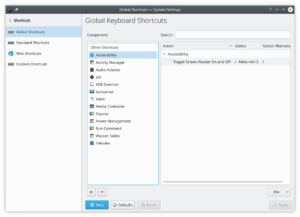Configuração do Sistema/Atalhos e gestos
 |
Edit system wide keyboard shortcuts and mouse gestures |

Custom Shortcuts
Here you edit settings for input actions, including mouse gestures.

Standard Keyboard Shortcuts
Here you can configure the keyboard shortcuts for a number of actions common to many applications. This includes actions such as Open, Save, Close, Cut, Copy, Paste, Find, and many more.

Global Keyboard Shortcuts
Global keyboard shortcuts are used to interface with applications that do not display an interface. Settings for such shortcuts are edited here.
Gestos do mouse
The place where you start is (in KDE SC 4.5 it is )
Ativar os gestos do mouse
No canto inferior esquerdo da janela existe um botão de . Certifique-se de que a opção esteja selecionada. Defina o tempo de espera que achar mais conveniente. O botão do mouse pode ser diferente para você, eu escolhi o 3 para usar o botão direito do mouse. Se você deseja que as ações de entrada sejam ativadas automaticamente, selecione a opção "Iniciar o serviço de ações de entrada no login" acima.
Creating the Mouse gestures actions group
Right click on the left pane (in an empty area under the list of action groups) and choose , rename that group to "Mouse Gestures" and check the checkbox attached to its name.
Creating a new mouse gesture
From now on I will assume that the new group is called "Mouse Gestures". Right click on and choose (here there are three options but I didn't manage to work with "Send Keyboard Input") using "Command/URL" or "D-Bus Command" you will need to create a gesture and bind an action to it.
To create the gesture
Click on your and select the tab. in the bottom of the screen there is an button (click it). In the box that just opened draw your gesture using the left mouse button.
To bind an action
if you chose simply enter that command/url under the tab at the field.
Examples using Command/URL
Close window
This command will let you close the next window you mouse click on.
Command/URL: wmctrl -c :SELECT:
to close the active window
Command/URL: wmctrl -c :ACTIVE:
Translate clipboard content
This command will display a translation of the current clipboard content.
- Required for this are:
- xclip
- libtranslate
Command/URL: kdialog --title "Translation" --msgbox "`xclip -o | translate -f en -t he -`"
Replace 'en' and 'he' with the desired source and destination language, if you are not sure, a full list of language codes is available from the ISO 639-2 list.
Examples using D-Bus
If you chose D-Bus, here are few examples.
Finding out what to fill where, is done with the help of the "Launch D-Bus Browser", using that browser you can find what method you wish to call in what application object. Using D-Bus we need to fill some fields, the field name will be regular and the content italic.
Runner
This will display the Runner dialog.
Remote Application: org.kde.krunner
Remote Object: /App
Function: org.kde.krunner.App.display
Audacious next/previous/pause/play/stop/repeat track
Remote Application: org.mpris.audacious
Remote Object: /Player
Function: org.freedesktop.MediaPlayer.Next (replace Next with Prev/Pause/Stop/Play/Repeat)
Audacious PlayPause track
If not playing will play, if playing will pause.
Remote Application: org.mpris.audacious
Remote Object: /org/atheme/audacious
Function: org.atheme.audacious.PlayPause
display the actions pop-up. (I am using that to search and translate words)
Remote Application: org.kde.klipper
Remote Object: /klipper
Function: org.kde.klipper.klipper.showKlipperManuallyInvokeActionMenu


